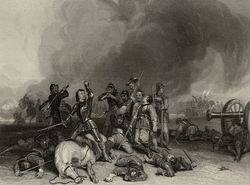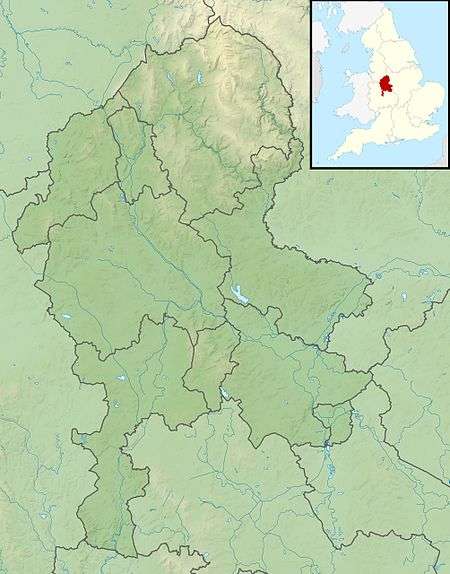Battle of Hopton Heath
The Battle of Hopton Heath was a battle of the First English Civil War, fought on Sunday 19 March 1643 between Parliamentarian forces led by Sir John Gell, 1st Baronet and Sir William Brereton and a Royalist force under Spencer Compton, 2nd Earl of Northampton.[2]
| Battle of Hopton Heath | |||||||
|---|---|---|---|---|---|---|---|
| Part of the First English Civil War | |||||||
 The Battle of Hopton Heath By J. T. Willmore after George Cattermole | |||||||
| |||||||
| Belligerents | |||||||
|
|
| ||||||
| Commanders and leaders | |||||||
|
Earl of Northampton † Henry Hastings Sir Thomas Byron |
Sir John Gell Sir Willam Brereton | ||||||
| Strength | |||||||
| 1,200[1] | 1,400[1] | ||||||

Background
On 6 March 1643, Sir John Gell successfully captured the town of Lichfield in Staffordshire. Gell then decided that he would attack the Royalist stronghold at Stafford which protected the Royalist's supply route between the ports of Yorkshire and their capital at Oxford.[2] To capture such a garrison, however, Gell would need reinforcements and therefore he arranged to meet and combine forces with the cavalry of Cheshire commander Sir William Brereton. The two Parliamentary leaders decided to meet at Hopton Heath on the 19th of the month. Meanwhile King Charles had sent an expeditionary force under the command of the Earl of Northampton on a mission to take control of the West Midlands and Staffordshire. Northampton had joined forces with Royalist allies led by Henry Hastings at Tamworth and on 18 March they arrived at Stafford.[1]
Battle
On the morning of 19 March, Gell arrived at Hopton Heath. The Royalist forces became aware of the presence of the Parliamentarians mid-morning and shortly thereafter they began their preparations to advance to Hopton Heath. At 14:00 hours, Brereton arrived at the heath. The Parliamentarians took a position along a ridge on the northeast side of the field. In total, the Parliamentarian forces consisted of 1400 men including 700 infantry, 300 dragoons, and 400 cavalry.[1]
At 15:00 hours, the Royalists arrived and deployed in battle formation to the south of the Parliamentarians. Their combined forces consisted of 1200 men including 300 dragoons and 800 cavalry. Hastings led the initial attack with his dragoons and was successful at pushing the Parliamentarians back at the edges. An exchange of artillery fire began with the Royalists doing the most harm with their large 29-pounder known as "Roaring Meg."[1][3]
Northampton then led two cavalry charges aimed at the Parliamentarian's centre. Each time his attack was repulsed. On the second charge, Northampton was thrown from his horse into the Parliamentarian line where he was killed after refusing quarter. The Royalists regrouped and Sir Thomas Byron led a third charge against the Parliamentarians, but to no avail. Hastings tried to rally the Royalists for a fourth charge, but their energy was spent. At that time Brereton led a Parliamentarian infantry attack and pushed the Royalists back recapturing some of the field and artillery that had earlier been lost.[1][3][4]
At dusk the fighting ended and the Parliamentarians left the field. The battle was over, not to be resumed. Brereton returned to his headquarters in Cheshire and Gell left for Derby abandoning the attempt to capture Stafford.[4] Because of the nature of the cavalry charges against a Parliamentary force composed largely of infantry, the casualties were heavily one-sided; the Parliamentarians had 500 casualties as compared to 50 killed or wounded Royalists.[1]
Aftermath
After the battle, both sides claimed victory. The Parliamentarians believed they had won in that they held the field at the end of the day and had killed the Royalist's commander, the Earl of Northampton. The Royalists believed that they had won the battle in that they reoccupied the field the next morning and had captured eight artillery pieces.[5]
With respect to the control of Staffordshire, Stafford was now free of Parliamentarian threat. Henry Hastings and the Royalists immediately tried to retake Lichfield and its strongly defended Close on 21 March, but failed. Two weeks later, Prince Rupert entered Lichfield and surrounded the Close. On 21 April Colonel Russell and the Parliamentarian garrison surrendered. Lichfield would then remain a Royalist stronghold for the duration of the Civil War.[6]
Citations
- Battle of Hopton Heath (1643).
- Castelow.
- English Heritage Battlefield Report: Hopton Heath 1643, p. 3.
- Plant (2006).
- English Heritage Battlefield Report: Hopton Heath 1643, p. 7.
- Lichfield: From the Reformation to c.1800.
References
- "Battle of Hopton Heath (1643)". Battlefields of Britain. CastlesFortsBattles.co.uk. 2019. Retrieved 27 April 2020.
- Castelow, Ellen. "The Battle of Hopton Heath". Historic UK. Historic UK Ltd. Retrieved 27 April 2020.
- "English Heritage Battlefield Report: Hopton Heath 1643". Historic England. English Heritage. 1995. Retrieved 27 April 2020.
- "Lichfield: From the Reformation to c.1800". BHO: British History Online. University of London. 2019. Retrieved 28 April 2020.
- Plant, David (2006). "Civil War in the Midlands, 1643". BCW Project. David Plant. Retrieved 27 April 2020.
General References
- Bennett, Martyn. Spencer Compton, Second Earl of Northampton, Oxford DNB, 2004